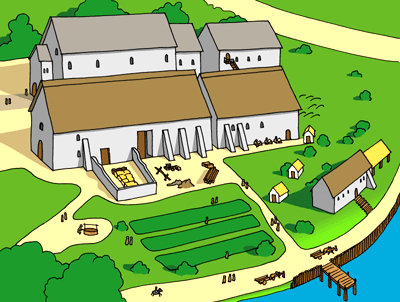|

|
|

Abbeys &
Priories: All about them
 Monasteries were places where
groups of men or women could live together and worship God.
The men were called monks and the women were called
nuns. Monasteries were places where
groups of men or women could live together and worship God.
The men were called monks and the women were called
nuns.- A monastery is sometimes
called an 'abbey' or a 'priory'. Monasteries for women are
also sometimes called 'nunneries' or 'convents'.
- Monasteries always had
lots of small buildings for the monks or nuns to live in.
These are called 'cells'. British ones were usually round.
Saxon ones were rectangular. There would also be a kitchen and workshops.
They could be built of wood or stone.
- Most important was the rectangular
church (British or Saxon)
to worship in. Saxon monasteries usually had more than
one church in a line (see picture of the Monastery at Jarrow).
- A wall around the
outside formed an enclosure. Monastery buildings within an
enclosure are called the 'enclave'.
- The first monastery in
Britain was set up in AD 429, by St. Cadfan on the Island of
Bardsey in North Wales. The first Saxon monastery was set up
by St. Augustine in Canterbury
in Kent.
- Double monasteries were
also popular. Here, men and women lived separately in two
enclaves, but
worshipped in the same church.
- An abbess was always in
charge of a double monastery.
- There was a famous
British double monastery at Gwytherin (in North Wales), set up
by St. Winifred. There was a famous Saxon one at Whitby (in
Yorkshire), run by St. Hilda.
- In the 10th century, St.
Aethelwold reformed all the Saxon monasteries.
he told them how they should set
out their buildings and what they should believe.
- Monasteries were very popular
in medieval times but, later, King Henry
VIII destroyed them all. A few were set up again in
Victorian times.
- Activity
Sheet available.
|

